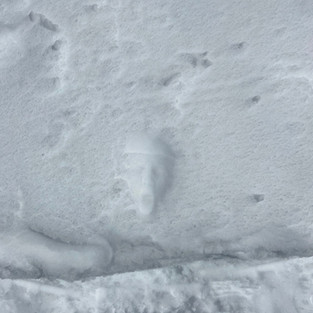

An exploration into visual illusions
Subjects:
Biology : Neuroscience
Perception: Light, color, seeing, optical illusions
Tools & Materials
Snow
Camera or phone with built-in camera
To Do & Notice
Go outside into the fresh snow! Find an area of untracked and undisturbed snow. Push your face into it gently. Lean back and observe your faceplant. What features can you see? Does it look concave (turned in) or convex (turned out)? Change your distance and observe again. Look at your faceplant up close, then move 3ft away and look at it. Move from side to side and observe your face plant from different angles. Close one eye and observe. Does anything change?
Take a photo of your faceplant from about 3 feet away. Observe the photo. Does your face look concave (turned in) or convex (turned out)?
Make more faceplants. Try smiling while making a faceplant. Get your family involved.
Post photos of your faceplant on social media and tag us @sweptahoe on Instagram and/or to @swep4 on Facebook. Be sure to hashtag and follow #SWEPsnippets. If you cannot post directly yourself, send SWEP your faceplant photos (Jenna@4swep.org). This way we can all see each other's faceplants…..and maybe your teachers’ too! Can you can identify who is who?
What’s Going On
Hollow-Face Illusion
Scientists who research visual perception have attempted to understand this illusion for centuries, but there is still much we don't know about how it works. One explanation is that a three-dimensional faceplant (or hollow mask) viewed from a few feet away will appear to be convex (turned out) towards the viewer like a normal face would even though it is concave (turned in). This illusion is your brain’s attempt to make sense of two conflicting sources of information. First, your visual system notices that the nose moves less than the other features when you change your angle of view. The brain then perceives that the nose is the most distant feature on the face and the face is concave (turned in) because distant objects appear to move less than closer objects. But based on experience in the world, your brain can’t accept the existence of a concave face. So, it concludes that the faceplant is instead an ordinary protruding face.
How do you think the hollow face illusion works? Conduct more experiments to try to understand this phenomenon. We hope you have a "jolly good time"!
Resources
Video that helps explain the hollow-face illusion:
Going Further
Try more optical illusion explorations from the Exploratorium:
Thank you to Tahoe Cross Country Ski Education Association for partnering with SWEP for this lesson.
Please review SWEP's Terms of Use prior to using this resource.






























Σχόλια